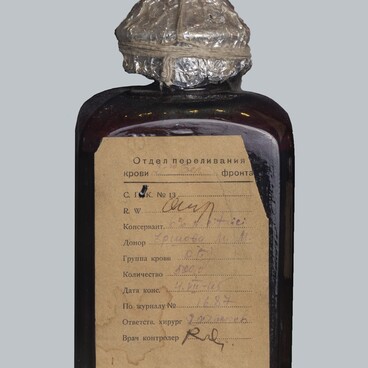The museum houses thousands of items that date back to the siege of Leningrad. They show how the efforts of doctors and scientists helped save millions of people. Employees of the Blood Transfusion Research Institute also contributed to achieving the Great Victory. Every day, they worked hard to ensure a sufficient supply of blood and blood products to hospitals across the Soviet Union.
Over the entire war period, there was only one day in September 1941 when volunteers did not come to donate blood. It was due to an air raid that lasted 18.5 hours. That day, 150 employees of the Leningrad Blood Transfusion Institute donated blood instead of volunteers. That way, they managed to meet the blood supply goals and support the war effort.
The Research Institute employees made sure that, from November 1941, only blood of the universal donor type O was supplied to the front. In total, the blood donated to military medical institutions included 95.3% of type O and only 4.7% of other types. Blood of other types was mostly supplied to civilian facilities.
Not all donor blood was used for transfusion. Some of it was also used to prepare blood products, which served as a basis for blood substitute solutions. One of them was the colloid blood substitute solution known as “L-103”. It consisted of proteins of heterogeneous blood, glucose, and salts.
The solutions were preserved in jars and ampoules. A sealed ampoule of this kind is displayed in the museum. Such a solution was used in the case of acute blood loss, burns, circulatory or operative shock. It was administered to the patient intravenously, with the infusion volume ranging between 250 and 1000 milliliters.
By the beginning of 1943, the Blood Transfusion Research Institute had preserved 13 tons of blood substitutes and antishock solutions, 308 liters of plasma, and 173 liters of serum. In 1943, the Institute also prepared 50 kg of an erythrocyte solution from production waste which was used for the treatment of dystrophy and scurvy.
The high quality of appropriately stored blood and blood solutions helped to prevent complications during blood transfusions. Severe adverse reactions occurred only in 1.4% of patients, and mild reactions — in 4.5%.
Over the entire war period, there was only one day in September 1941 when volunteers did not come to donate blood. It was due to an air raid that lasted 18.5 hours. That day, 150 employees of the Leningrad Blood Transfusion Institute donated blood instead of volunteers. That way, they managed to meet the blood supply goals and support the war effort.
The Research Institute employees made sure that, from November 1941, only blood of the universal donor type O was supplied to the front. In total, the blood donated to military medical institutions included 95.3% of type O and only 4.7% of other types. Blood of other types was mostly supplied to civilian facilities.
Not all donor blood was used for transfusion. Some of it was also used to prepare blood products, which served as a basis for blood substitute solutions. One of them was the colloid blood substitute solution known as “L-103”. It consisted of proteins of heterogeneous blood, glucose, and salts.
The solutions were preserved in jars and ampoules. A sealed ampoule of this kind is displayed in the museum. Such a solution was used in the case of acute blood loss, burns, circulatory or operative shock. It was administered to the patient intravenously, with the infusion volume ranging between 250 and 1000 milliliters.
By the beginning of 1943, the Blood Transfusion Research Institute had preserved 13 tons of blood substitutes and antishock solutions, 308 liters of plasma, and 173 liters of serum. In 1943, the Institute also prepared 50 kg of an erythrocyte solution from production waste which was used for the treatment of dystrophy and scurvy.
The high quality of appropriately stored blood and blood solutions helped to prevent complications during blood transfusions. Severe adverse reactions occurred only in 1.4% of patients, and mild reactions — in 4.5%.


